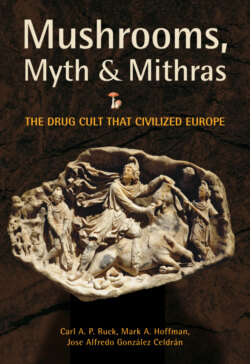Читать книгу Mushrooms, Myth and Mithras - Carl Ruck - Страница 9
На сайте Литреса книга снята с продажи.
The Imperial Cult
ОглавлениеThe Roman imperial court continued its official practice of Mithraism for 300 years. All the emperors were most likely adherents of the cult, but we learn of particulars only when they surface as anecdotal events. Thus Commodus (180–192) commissioned a bust of himself with a Persian cap in the likeness of Mithras,8 and we are told that he performed the Mithraic initiation with an actual human sacrifice, whereas the rite was intended only to intensely intimidate the candidate.9 Pliny was aware of this requirement of the initiation in asserting that Nero wouldn’t have hesitated to do the same in order to become a full Magus. Septimius Severus (193–211) and his Syrian empress Julia Domna, who also promoted the divinity of Apollonius of Tyana (a Cappadocian Greek contemporary of Christ) added a Mithraeum to the house of Trajan (98–117). The famous Roman baths of their son Caracalla (211–217) included a subterranean Mithraeum. Each in the succession of caesars who were created by the support of their armies in the third century was bound to support the Mithraic religion of their soldiers.
Valerian (253–260) mercilessly purged the empire of Christians and declared December 25 the festival of the Unconquered Sun, as the days begin perceptibly to lengthen after the winter solstice. The Christians would eventually adopt this date for the birth of their god. Valerian’s son and coregent Gallienus had himself depicted as that Sol Invictus (Invincible Sun) on his coinage. Diocletian (284–305) after his retirement dedicated a great altar to Mithras at the Carnutum Mithraeum on the Danube in the year 307, and he placed the entire empire under the god’s divine protectorate. Diocletian court was commonly seen as an imitation of the Sassanid dynasty that had replaced the Parthians and was seen as the second Persian Empire (226–651). Mithraic clergy in his court were suspected of instigating his persecution of the Christians in 303 under his son-in-law Galerius Maximianus.
Julian the Apostate (361–363), in his attempt to reverse the Conversion to Christianity and revive the old pagan religions, was himself initiated by the philosopher Maximus of Ephesus, perhaps also with a human sacrifice (at least according to his detractors.) He had a Mithraeum erected in his palace in Constantinople. Like Nero, he saw himself as the incarnation of the god Mithras. Ever since childhood, he had cherished a secret devotion to the god Helios as his spiritual father. He died during his expedition against the Persians, apparently desiring to conquer the land that had given him his religion, assured that his tutelary deity would grant him victory.
In 361, adherents of the briefly restored pagan religions lynched George the Arian, bishop of Alexandria (later to become Saint George) when he attempted to build a Christian church above one of their underground sanctuaries. According to the legend, the Mithracists tied him to a camel, tore him to pieces, and then burnt him with the beast.
An adytum of vast depth was discovered which unveiled the nature of their heathenish rites: for there were found there skulls of many persons of all ages, who were said to have been immolated for the purpose of divination by the inspection of entrails, when the pagans performed these and such magic arts whereby they enchanted the souls of men.
—Socrates Scolasticus-Sozomen, Ecclesiastical History, 3.210
By 312 the conversion of Constantine, who as a soldier and a worshiper of the Sun was likely a Mithraic initiate, had dealt the cult a serious blow. The vision that precipitated his conversion indicated the superiority of Christ, for he saw a cross shining above his former god, the Sun. However, the interpretation of his imperial standard is ambiguous and can easily be seen as Mithraic, and he styled himself as an avatar of Mithras. He did, however, institute a policy of religious tolerance, which set the groundwork for the freedom usurped in the cause of radical intolerance.11
He said that about noon, when the day was already beginning to decline, he saw with his own eyes the trophy of a cross of light in the heavens, above the sun, and bearing the inscription, CONQUER BY THIS.
—Eusebius, Conversion of Constantine, 28
Subsequently, the dominating Christians attempted to eradicate the religion with all the fervor of persecution that they themselves had recently suffered, desecrating the sanctuaries and even murdering Mithraic priests. In the Saarburg Mithraeum the skeleton of a man was found lying face downward with his wrists bound with an iron chain behind his back, probably a priest murdered and ritually cursed. His burial in the sanctuary was meant to desecrate it for all eternity.
